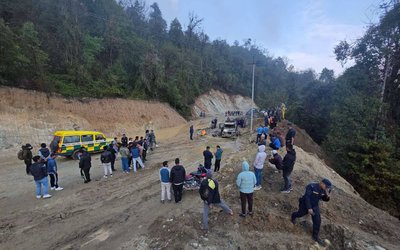
Nepal Faces Impacts Of Climate Change: NCCIS
Conducted by Central Bureau of Statistics (CBS), National Climate Change Survey (NCCIS) reveals that impact of climate change is real in Nepal.
According to survey report, 99.33 percent of households note more drought in last 25 years. This indicates that Nepal is already at the receiving end of climate change in a number of ways.
According to the study, the impact of climate change has been experienced in various sectors, mainly in agriculture, forests and biodiversity, water resources and the energy sector.
Based on the survey conducted in 5,060 sample households from 253 primary sampling units in 16 various strata representing three different ecological zones, the report said that there increase significant numbers of incidents in draught, landslides and avalanches. People also report that there appear new insects and diseases.
According to survey, 84.47 percent of households had observed significant decrease in the amount of surface water, with a majority of households in the mountain and hilly regions experiencing complete drying up of surface water as well as underground water.
A majority of households (50.63 percent) reported early flowering/fruiting of plants and increase in invasive species of shrubs (92.03 percent), while they experienced a significant decrease in the number of trees, shrubs, medicinal herbs, non-timber products, aquatic plants, wild animals and birds.
According to NCCIS, 86.1 percent households reported experiencing draught, 84.58 percent reported that the monsoon is delayed by 1 to 4 weeks and 57.14 percent households said they observed delays in winter rains by 1 to 4 weeks.
97.69 percent households observed an increase in diseases/insects and sporadic rainfall, 74.29 percent households observed changes in water sources, and 60.25 percent an emergence of new diseases in crops. All households in the sub-alpine region said that there increase in draughts, landslides, avalanches and disease/insects in the past 25 years.
According to survey, the affected households have been adopting various climate change adaptation measures. Among the 25 farm and 7 off-farm based adaptation measures identified, most households reported using chemical fertilizers, putting additional investments into protecting livestock from disease, cultivating mixed crops and improved crop varieties to deal with the impact of climate change.

- TEACHERS ON STRIKE: Students' Future In Jeopardy
- Apr 25, 2025
- NEPAL-THAILAND: Joint Business Council
- Apr 13, 2025
- BIMSTEC SUMMIT: Nepal’s Stand
- Apr 11, 2025
- IME GROUP: Expands Into Paper Industry
- Mar 24, 2025
- CPN UML: Instigated By India
- Mar 23, 2025















